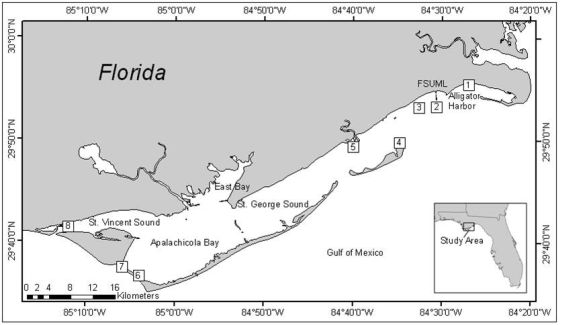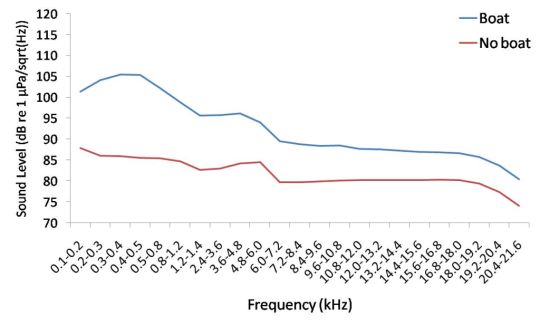
[ Lay Language Paper Index | Press Room ]
Athena M. Rycyk, Rycyk@ocean.fsu.edu
Florida State University Department of Oceanography,
Tallahassee, Florida, 32306
Douglas Pl. Nowacek
Florida State University Department of Oceanography,
Tallahassee, Florida, 32306
Popular Version of Paper 3aAB3, “Acoustic environments of bottlenose dolphins (Tursiops truncatus) in the Big Bend region of Florida”
Presented 8:35 a.m. Thursday Morning, November 29, 2007
154th ASA Meeting, New Orleans, LA
Bottlenose dolphins live in an aquatic environment where sound can travel faster and farther than on land, a fact they exploit by using sound to communicate, navigate, and find food (fish). Dolphins, however, are not the only source of sound in the oceans; boats and fish can add to the cacophony.

We recorded sounds from eight different sites in the Big Bend region (the panhandle, Figure 1 shows the sampled sites) of Florida and found each location has a unique soundscape (a description of what sounds are or are not present, the sound levels (loudness), and how often these sounds occur).
Toadfish, silver perch, and sea catfish sounds were heard at four out of the eight locations, and these species were found to vocalize at different times of the day.
 |
| Figure 2 shows the times (where 0 is at midnight, 12 are at noon) at which toadfish and silver perch produced sound at a site during spring. |
Toadfish produced sound around the clock, but only chorused (vocalized in unison) around sunset. Silver perch were only heard at night around 9 PM, and almost exclusively produced sound in choruses. Bottlenose dolphin vocalizations were heard at six out of the eight sites. Both the rate and types of dolphin vocal activity varied greatly between locations. For example, Alligator Harbor and West Pass had a higher ratio of whistles (socialization sounds), to echolocation (foraging sounds), than other sites such as Dog Island.
These differences can help us determine how dolphins use certain areas, such as a high level of echolocation could mean dolphins frequent that area for foraging. Human-made sounds, such as boats can mask the sounds dolphins and fish produce.
 |
| Figure 3 shows the sound levels over a range of frequencies for sound clips that contained boat noise and those that did not; when boats are heard sound levels are much louder, drastically altering the soundscape. From human-made sounds to biological sounds, the Big Bend region hosts a variety of soundscapes, showing what a wide variety of sounds bottlenose dolphins hear in their natural environment (example sound clips are included). |